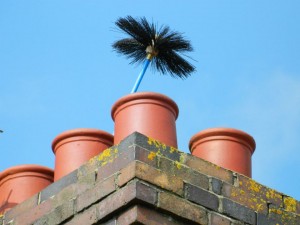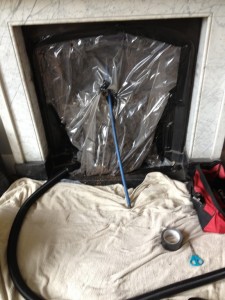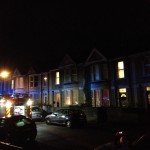
Ensure your chimney is safe.
Hopefully the information in this post will go some way to helping people understand more about using maintaining and being safe with log burners and open fires. Firstly regular sweeping of your flue or chimney will eliminate the build-up of soot and clear obstructions such as bird or animal nests, cobwebs, leaves and debris.
You will also reduce emissions into the atmosphere by assisting the complete combustion of the fuel you choose to use. Contrary to belief it is not sufficient to use a vacuum cleaner. You should always ensure your chimney is inspected regularly by a trained professional to prevent fires breaking out.
The most common causes of chimney fires are: infrequent sweeping or cleaning, burning unseasoned wood, improper appliance sizing and overnight burning/slumbering of wood for long periods in wood/multifuel stoves.
It is important when burning wood to ensure the wood is either kiln dried or well-seasoned this means less than 20% moisture content, moisture meters are now widely available from most good hardware stores to allow you to check your wood is 20% or less. Burning wet, newly felled or coniferous woos can cause tar or creosote to form in the stove and chimney which can be extremely hazardous,
For open fires have your chimney swept before lighting the first fire of the winter, Always place a fireguard in front of the fire, do not overload the grate or build the fire too high, dispose of ash properly and regularly. Do not dry or air clothes in front of the fire and ensure the fire is out before you go to bed and finally never use paraffin or petrol to light a fire in your house.
For wood burners and multi fuel stoves make sure the appliance is installed and serviced by a competent engineer, it is really important to use the correct sized stove for the room one that is too large will not get hot enough to burn the fuel in the wood and unburnt fuel will go into the chimney or flue and cause creosote which is highly flammable when stuck to the walls of the chimney or flue. Ensure the room is well ventilated do not cover vents. If the stove has been used to slumber this should be followed by a period of faster hotter burning to dry out any creosote and warm the chimney again finally never use your stove as an incinerator for bills or rubbish this will cause hazardous situations within the chimney or flue.
How often should you have your chimney swept? Well in Bristol the Avon and Somerset fire Brigade recommends the following frequencies as guidance however they do depend on a lot of other factors such as appliance duration of use fuel used but your chimney sweep will be able to offer further advice once they have swept your chimney :
- Smokeless fuel = At least once a year
- Wood = Quarterly when in use
- Bituminous coal = Quarterly when in use
- Oil = Once a year
- Gas = Once a year
- Finally Carbon Monoxide – be aware
Carbon Monoxide (CO) gas can kill. Heating and cooking appliances fuelled by wood, oil and gas can cause CO poisoning if they are poorly installed, incorrectly used or if they are not properly maintained. Early symptoms of CO poisoning include tiredness, drowsiness, dizziness, chest pains, nausea and flu like symptoms. You will reduce the risks of CO poisoning by having appliances installed properly and maintained regularly by competent people, getting you chimney or flue swept regularly and not overloading a fire, keeping rooms well ventilated and ensuring you have a carbon monoxide alarm that is tested regularly #testittuesday is a great way to remember to test your CO alarm.
At Cheroo Chimney Sweeps our aim is to give a great all round service to keep you and your family safe, so please take on board the tips and information this blog provides and feel free to contact us for anything chimney sweeping related we have a HETAS registered engineer for installations and fault finding and offer a professional sweeping service for open fires and stoves.







